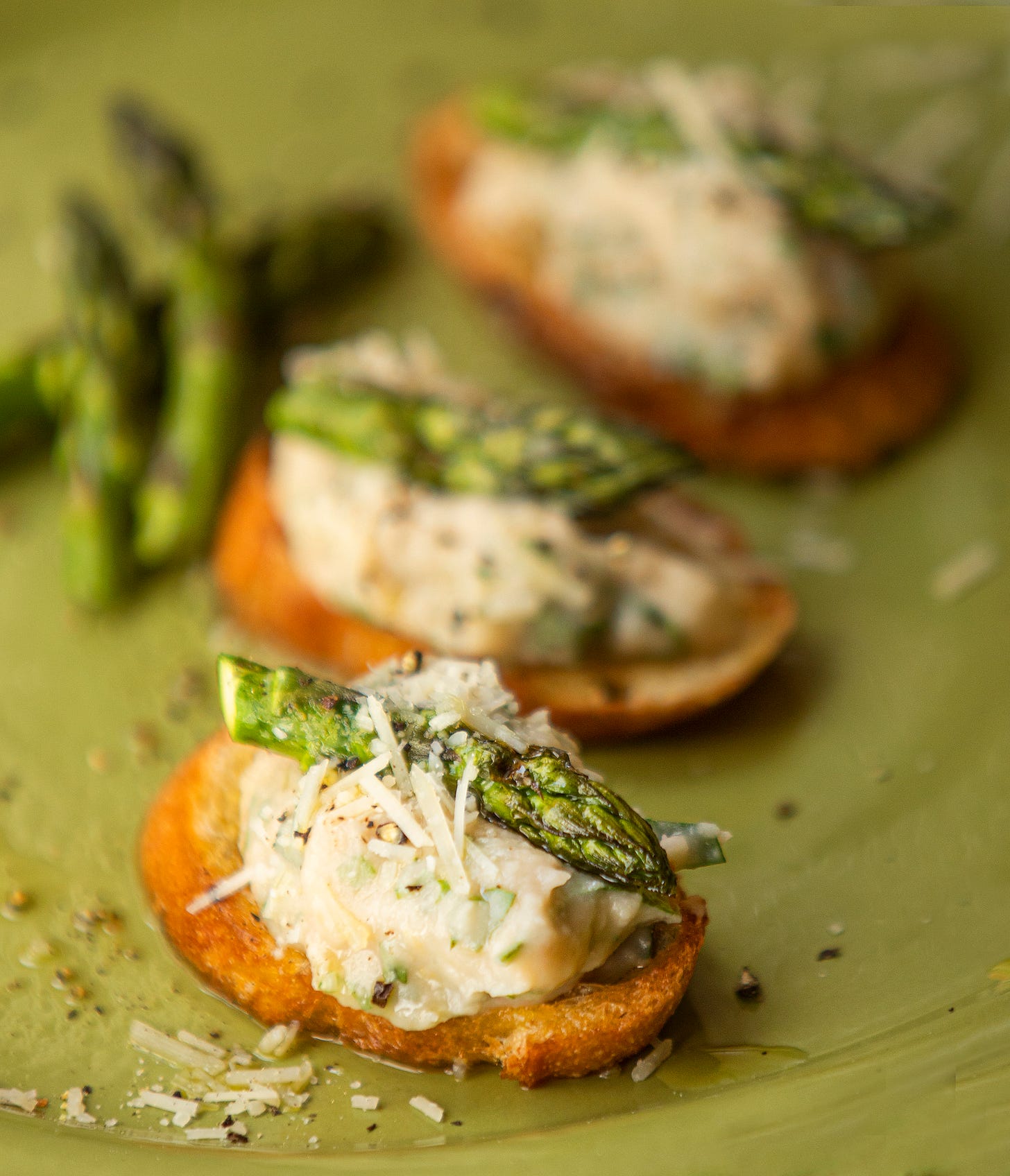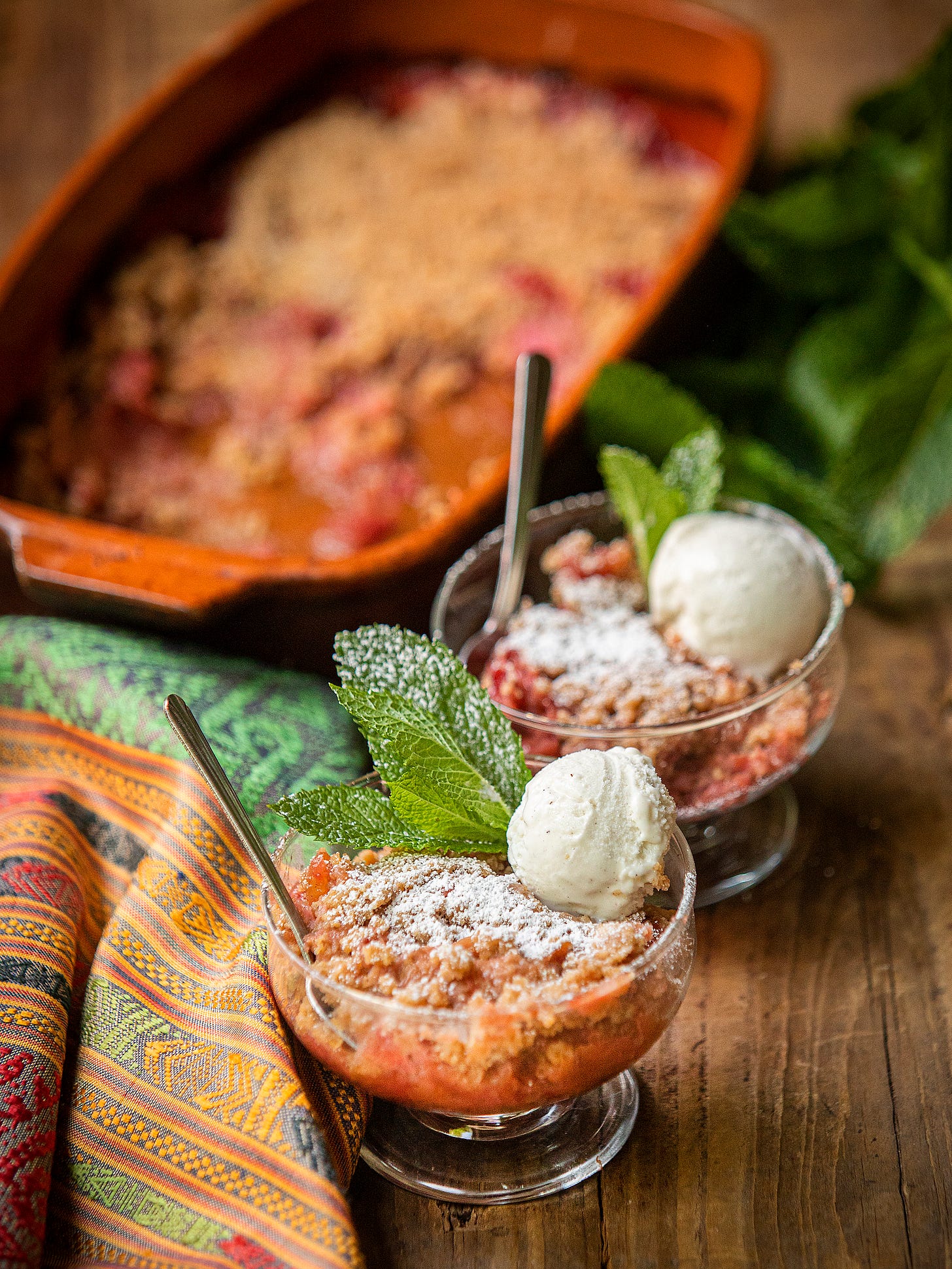I’m always reminded of that quote from Robin Williams when spring comes:
"Spring is nature's way of saying, 'Let's party.” Everything seems to come alive overnight. There are so many delicious ingredients that are only available basically in Spring: Asparagus, spring peas, wild mushrooms, fava beans, citrus, spring lamb and rhubarb come to mind. Here are some spring recipes to celebrate this magical time of renewal.
WHITE BEAN AND GRILLED ASPARAGUS CROSTINI
Makes 16 - 20 hors d’oeuvres
I also like to use these as an addition to a salad of baby greens dressed with a little citrus vinaigrette.
5 tablespoons olive oil
1 cup chopped onion
3 tablespoons chopped garlic
2 cups cooked and drained white beans such as cannellini, gigande or flageolet
2 tablespoons soy sauce
2 teaspoons finely grated lemon zest
3 tablespoons lemon juice
3 tablespoons chopped parsley
1 tablespoon chopped mint
Salt and freshly ground pepper
1/2-pound tender young asparagus
Lemon or truffle extra virgin olive oil
Toasted crostini to serve
Heat 3 tablespoons of olive oil in a sauté pan and add onions and garlic and sauté over moderate heat until vegetables just begin to color. Add the beans and heat through. Add mixture to a food processor along with soy sauce, lemon zest, lemon juice, parsley and mint and process in short bursts until fairly smooth (still should have a little texture). You may need to add a bit of broth or bean cooking liquid to facilitate. Season to taste with salt and pepper.
Lightly oil asparagus with remaining olive oil and season with salt and pepper. On an outdoor or stovetop grill pan, quickly grill asparagus until crisp-tender. Set aside.
To serve: Spread each crostini with a heaping tablespoon of the bean puree. Top with grilled asparagus cut to fit and drizzle each with a few drops of lemon olive oil.
FRESH PEA AND MOREL RISOTTO WITH PEA BROTH
Serves 4 to 6
This is a lovely spring dish when tiny peas and fresh morels are at their best. The pea shoot garnish can be gathered in your garden if you have one or are available in Asian markets. Fresh morels can be hard to find so use whatever special mushroom you can get.
6 - 7 cups rich chicken or vegetable stock
3 tablespoons butter
3 tablespoons olive oil
1/3-pound fresh morels carefully cleaned of any debris
Salt and freshly ground pepper
1/2 cup finely minced onion
2 teaspoons minced garlic
1/4 cup finely chopped celery
2 cups Arborio rice
1/2 cup dry white wine
1 1/4 cups fresh shelled tiny peas
3 tablespoons chopped chives
1/3-1/2 cup freshly grated asiago or parmesan cheese
1 teaspoon finely grated lemon zest
Pea Broth (recipe follows)
Garnish: fresh pea shoots or tendrils
Heat the stock in a saucepan and keep warm over moderate heat.
Melt two tablespoons each of the butter and oil in a sauté pan and sauté morels over high heat for 2-3 minutes or until just cooked thru. Season with salt and pepper and set aside.
Add remaining butter and oil to a deep saucepan and sauté onions, garlic and celery until softened but not brown. Add rice and sauté for 2 minutes more or until well coated. Add wine and stir with a wooden spoon until most of it is absorbed. Add the hot broth in 1/2 cup or so increments and stir until it is mostly absorbed. Continue adding broth, stirring and cooking until rice is creamy on the outside but still has texture on the inside of each grain.
Stir in peas, reserved morels, chives, cheese and zest and remove from heat. Season to taste with salt and pepper and spoon into the center of warm bowls. Pour some of warm pea broth around and top with pea shoots. Serve immediately.
Pea Broth:
The simplest way to make this is to use a juicer. Simply run fresh young sweet peas thru the juicer to make 1 1/2 cups of pea juice. Alternately puree cooked peas in a blender. Place in a saucepan along with 1/4 cup or so rich chicken or vegetable stock. Bring to a simmer and whisk in 1-2 tablespoons softened butter. Season to your taste with salt and pepper.
SPRING LAMB WITH ROSEMARY AND SALSA VERDE
Serves 4 to 6
In many parts of the world true tender “Spring” milk-fed lamb is available for a short time and is less than 6 weeks old. You won’t see it in America partly because it is expensive and because many of us have an aversion to harvesting such a young animal. Our “Spring” lamb is three to five months old, born in late winter or early spring and sold usually before the first of July. For the following recipe look for smaller racks hopefully from a local and/or organic rancher. If it hasn’t already been done, ask your butcher to “French” the racks for you. This means trimming the bones of their fat and gristle. You can also do it yourself. There are lots of prompts illustrating on the internet.
Two 8-bone racks of lamb, well-trimmed and frenched
Kosher salt and freshly ground black pepper
3 garlic cloves mashed into a paste with a little salt
2 tablespoons finely chopped fresh rosemary
A glug or two of olive oil
Rosemary sprigs for garnish
Salsa Verde, optional (recipe follows)
Season the racks liberally with salt and pepper. Using your hands, massage each rack with the garlic, rosemary, and a little drizzle of olive oil. Place the racks, fatty side up, in a roasting pan and leave them at room temperature for an hour or so.
Preheat the oven to 400°F.
Roast the racks for about 20 minutes, until they’re nicely browned and have an interior temperature of 125°F on an instant-read thermometer for medium-rare. Remove from the oven, cover loosely with foil, and let rest for about 10 minutes. Turn off the oven and place a serving platter in the oven to warm.
Transfer the racks to a cutting board. Slice between the bones and arrange the lamb chops on the warm platter with rosemary sprigs. Serve with salsa verde if desired.
Salsa Verde
Makes about 1 cup
This is a quick little sauce of Spanish origin that is delicious on all kinds of grilled, pan seared or roasted meats, fish and vegetables. Note that I’ve used poached garlic rather than the fresh raw type. I think this is important if you are going to make the sauce ahead. Within a short time, raw garlic can become harsh and hot. Poached garlic maintains its more subtle and sweet flavor and doesn’t overpower the sauce as it sits.
1 cup coarsely chopped parsley
4 anchovy fillets in oil
2 tablespoons drained capers
2 tablespoons poached garlic (see note below)
2 tablespoons chopped fresh basil or mint, or 1 tablespoon chopped fresh tarragon
1 tablespoon finely grated lemon zest
2/3 cup or so fruity extra virgin olive oil
Salt and freshly ground black pepper to taste
Add the parsley, anchovies, capers, garlic, basil and zest to a food processor or blender. With machine running, slowly add the oil until just blended. Sauce should still have a little texture. Season with salt and pepper. Can be stored covered and refrigerated for up to 1 day.
Note: To poach garlic, separate cloves but don’t peel. Place in a small saucepan and cover with at least ½ inch of cold water. Place on stove over high heat and bring to a boil. As soon as water boils, drain and rinse to cool off cloves. Remove husk from the garlic and store covered in refrigerator for up to 2 weeks.
DID YOU KNOW
Is it always necessary to allow roasted or grilled meat to rest before carving?
Ever wonder why recipes call for allowing roasted meat to sit for a few minutes after you take it out of the oven or off the grill? The reason for this is that the meat near the surface contains less juice just off the heat than it did when you started to cook it. During cooking the juices near the surface evaporated from the heat or are driven toward the center.
If you carve immediately after cooking, while these juices are still unevenly distributed, the meat toward the edges will be dry. Also, you’ll lose juices because the meat in the center can’t hold all the accumulated juices that collected there during cooking.
A few minutes rest gives the juices a chance to redistribute themselves, through osmosis, throughout the meat. So give chickens or thick steaks at least 3 to 5 minutes before cutting and large roasts such as prime rib of beef or leg of lamb at least 15 minutes.
RHUBARB CRISP
Makes 6 to 8 servings
For the filling:
2 pounds fresh rhubarb trimmed and thickly sliced crosswise
3/4 cup granulated sugar
2 tablespoons chopped candied ginger
2 teaspoons grated orange zest
2 tablespoons Grand Marnier, optional
For the streusel topping:
3/4 cup all-purpose flour
1/4 cup light brown sugar
1/2 teaspoon ground cinnamon
Big pinch kosher salt
7 tablespoons cold unsalted butter, cut into 1/4-inch pieces
Whipped cream or ice cream for serving
Position a rack in the center of the oven and preheat to 425°F.
In a large saucepan over medium-high heat, combine the rhubarb, sugar, ginger and orange zest and simmer until the sugar dissolves into a syrup and the rhubarb is nearly tender, about 8 minutes.
Make the streusel topping: Add the flour, brown sugar, cinnamon, and salt in the bowl of the food processor and pulse to combine. Add the butter and pulse until the mixture resembles very coarse crumbs with pea-sized blobs of butter.
Dump the rhubarb mixture into a 6-cup gratin dish and sprinkle the flour mixture evenly over the top. Bake until the topping is golden brown, about 25 minutes. Let the crisp cool a bit and serve it warm with a dollop of whipped cream or a scoop of ice cream.
This is also a delicious dish to serve this spring, when favas, fennel, and citrus are at their best: SMOKED SALMON, CITRUS, AND FAVA BEAN SALAD
John Ash © 2025







